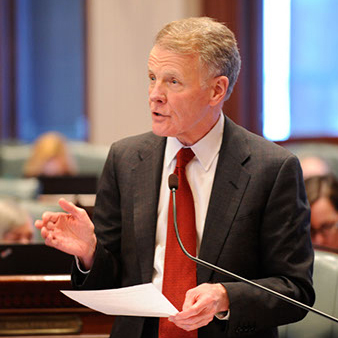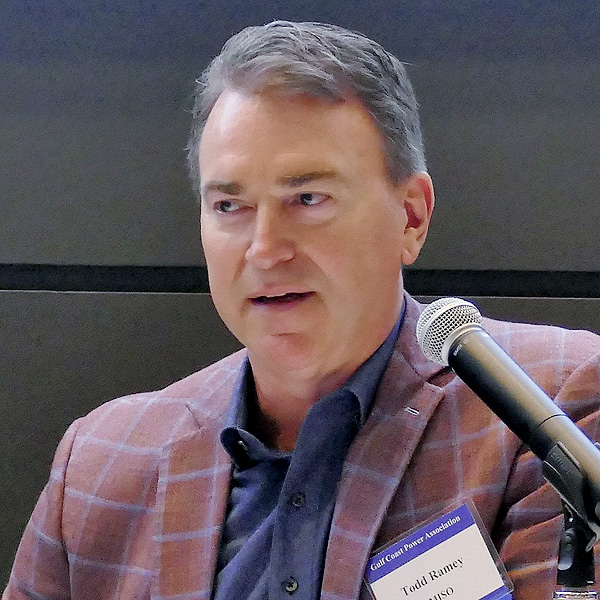WASHINGTON — The Inflation Reduction Act and Infrastructure Investment and Jobs Act passed last year have given the renewable energy industry policy certainty with hundreds of billions of dollars in funding, but the industry faces some challenges in maximizing its opportunity.
“For the long term, we have the challenge ahead of us on transmission, building up the workforce that we need, on supply chain — all those things need to come together,” Enel North America’s head of public policy, Jack Thirolf, said at ACORE’s Policy Forum on Thursday. “And we need to not wait.”
One of the short-term issues facing the industry is waiting for the Treasury Department to implement many of the IRA’s tax provisions, but that has not stopped development, according to Bank of America Managing Director Ray Wood.
“We haven’t stopped to wait for guidance,” said Wood. “We continue to work on transactions. We’re seeing an incredible flow of opportunity to deploy capital. And we’re very excited about the prospects of the IRA bringing down the cost of capital for our clients and for the industry, thereby allowing for more deployment to bring in domestic manufacturing.”
General Electric (NYSE:GE) thinks about the transition to a clean grid globally, which means it has to start making decisions about which technologies to ramp up manufacturing now so they can be deployed as needed, said GE Renewable Energy Senior Executive Director Chrissy Borskey.
“There’s got to be some things that, as an industry, we can start thinking about it, and we can start saying, ‘This is what we need today,’ or ‘this is what we need in the next three months,’” said Borskey. “And we’re going to have to prioritize.”
Meta (NASDAQ:META) Head of Renewable Energy Urvi Parekh said the internet giant has been on average making about 2,000 MW worth of renewable power purchase agreements every year recently, but this year could threaten that streak. The industry needs guidance on exactly how the IRA’s incentives will work, and that uncertainty is leading to more expensive PPAs.
“I’ll know it’s working when we start to see clarity in the prices that we’re seeing,” Parekh said.
Supply Chain Issues Must be Overcome
Another challenge that has roiled the industry along with the rest of the economy recently is the supply chain. The new laws require more domestic manufacturing of goods such as solar panels, which are dominated by China now.
The Chinese dominate the manufacturing of polysilicon and wafers, which are key components to manufacturing solar, said Becca Jones-Albertus, director of the Department of Energy’s Solar Energy Technologies Office.
“A supply chain that has a heavy domestic component brings all kinds of other benefits,” said Jones-Albertus. “Economically, it brings resilience to shipping issues, in which we saw seeing a huge cost increase over the last couple of years.”
Onshoring the supply chain also means more jobs and all the economic benefits that come with increased employment, she added.
Ørsted Americas Head of Program Execution Troy Patton said his firm, which is building seven offshore wind projects off the East Coast, buys from the entire market, so as long as supply can meet demand, the Danish firm does not run into supply chain issues.
“As long as there’s economically feasible supply, we’re happy with the security of supply,” Patton said.
However, while the onshore wind industry in the U.S. has developed its own domestic manufacturing and supply chains, the more nascent offshore industry has not, to the point where Ørsted is having to import all the major components for its first projects, he added.
Securing the solar supply chain is going to involve a lot of tough work, said Nextracker Vice President of Government Affairs Kathy Weiss. Her firm found some success in getting “trackers” that help panels follow the sun built domestically, but that involved reaching out to steel manufacturers and assuring them that the demand for the devices would be there for years to come.
China built up its dominance over 20 years, but the U.S. Commerce Department has issued tariffs on that country, in what has become a bipartisan and popular policy.
“For 20 years, China has been publishing a five-year plan that says, ‘We’re going to dominate,’” Weiss said. “And so now we just figured that out, and we’re trying to react to it; I hope the reaction is one that is smooth and not jarring for the industry.”
An executive order from President Biden gave the industry a stay on the tariffs, which will give it a couple years to rearrange supply chains and use IRA funding to build up domestic manufacturing of solar, she added.
“All our companies across the industries have jumped on that and are working 24/7 to try and stand up fast; to get partners that we’ve worked with offshore to bring them the equipment onshore; to get the equipment set up; get the workers trained; to get the steel prepared,” Weiss said. “So that activity is happening at every renewable energy company across the United States.”
Grid Needs to Triple in Size
Fully decarbonizing the electric sector is going to take massive amounts of new resources, with DOE’s latest modeling showing another terawatt each of wind and solar, about 500 GW of other renewable sources and 300 GW of battery storage. Linking it altogether will also require significant amounts of new transmission, said acting Assistant Secretary for Energy Efficiency and Renewable Energy Alejandro Moreno.
“The modeling that we’ve done looks at sort of the base scenarios that we have increasing transmission by three times above current levels,” he added.
Federal support is needed to get that transmission built out, but it is not enough on its own, said Brian George, Google’s (NASDAQ:GOOGL) U.S. federal lead on global energy market development.
“The large buyers who need access to transmission really have an obligation to be engaged in our communities, in our local environments, to talk about the benefits that these projects have,” George said.
Cost allocation is another key area that needs to be tackled, and that will largely involve states coming to an agreement on where the most beneficial pathways for power are and agreeing to share the costs of new transmission, he added.
The industry has been run the same basic way for 100 years, with policies on top of an original framework that needs to be reformed from the ground up, said Breakthrough Energy’s manager of U.S. policy and advocacy, James Hewett.
“So how do we start to kind of pull those bricks down and build the grid that we know that we need?” said Hewett. “And that’s obviously going to be a really difficult challenge.”
The grid is the “most important machine in our society,” and too often transmission expansion is narrowly focused on the needs that one project will address, said Dominion Energy Senior Vice President of Corporate Affairs William Murray. Such a narrow focus means most people will never be interested in that work.
“What we’re doing instead is strengthening the most important machine in our society for decades and decades,” Murray said. “But we’re also enabling the most significant economic transformation since the internet. And that’s kind of cool.”
FERC is not focused on bringing down barriers to new transmission because it is doing the job assigned to it instead: making sure rates are just and reasonable, said its special counsel, Kim Smaczniak.
The commission has three proposals aimed at improving its transmission regulations, including a Notice of Proposed Rulemaking on transmission planning that would require more long-term planning of 20 years based on various scenarios of a future grid. It also has a NOPR on changes to interconnection queues to speed up the process of connecting new generators, after many of the current rules have led to ever ballooning delays for projects.
The third major rule Smaczniak and colleagues at FERC are working on is an update to the commission’s backstop transmission siting authority from the Energy Policy Act of 2005, which was recently clarified in the IIJA to say that the federal agency can overrule a state that rejects a line.

